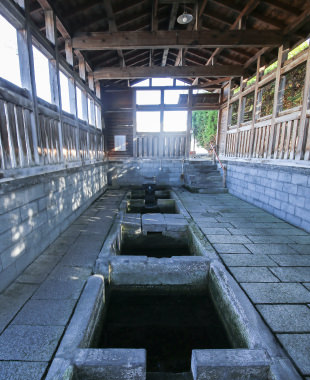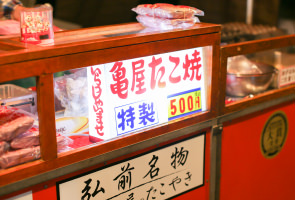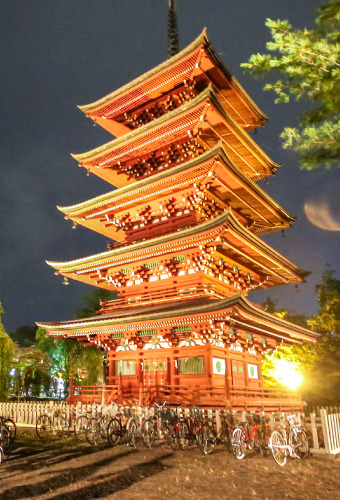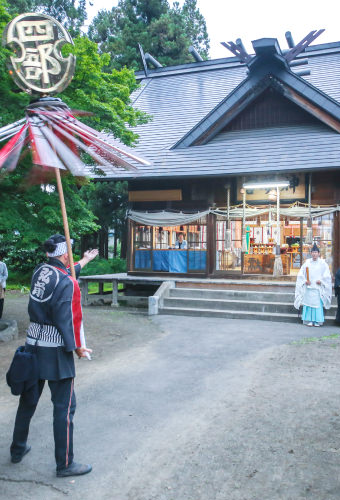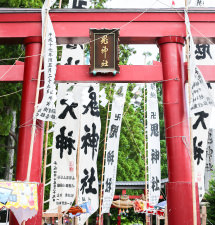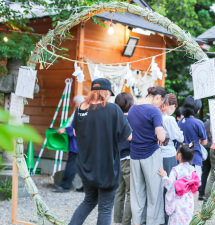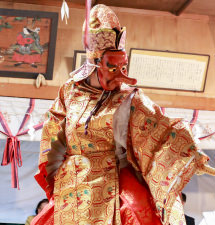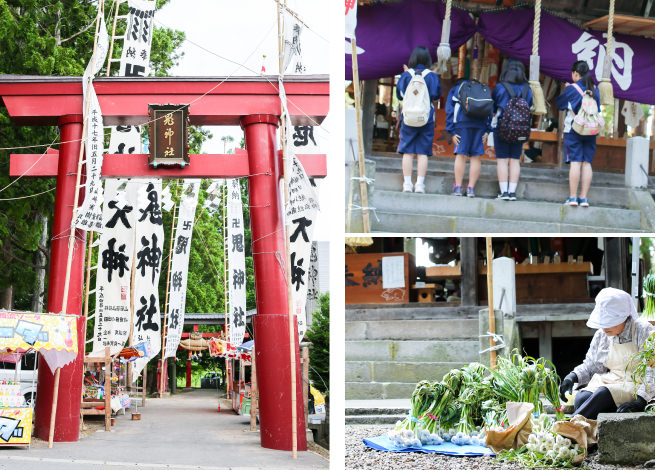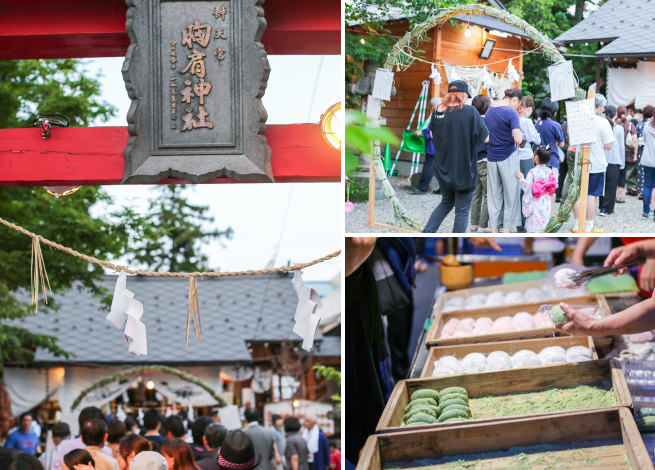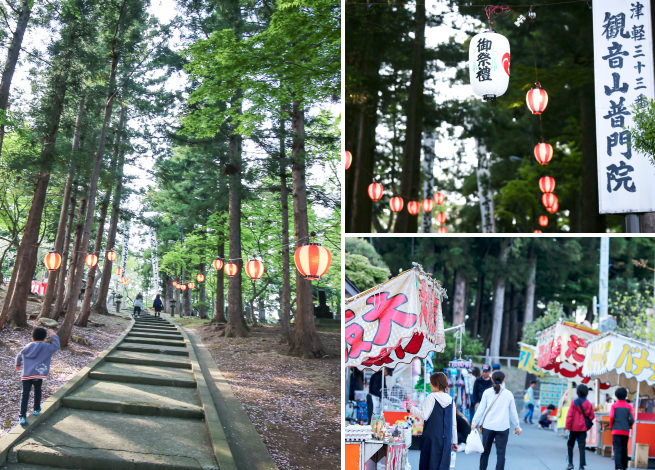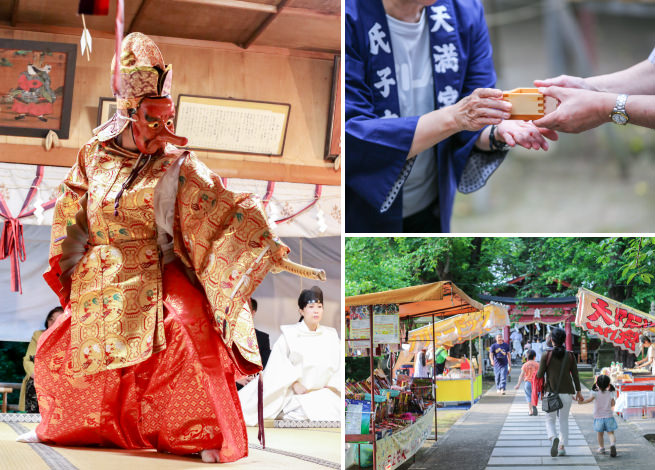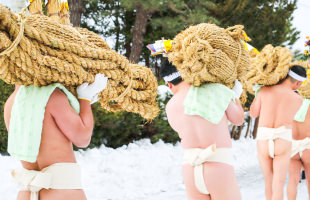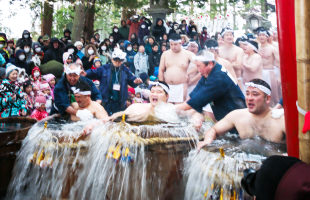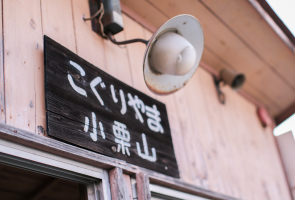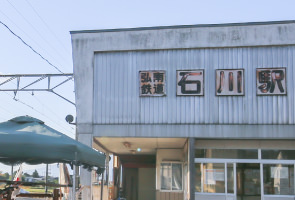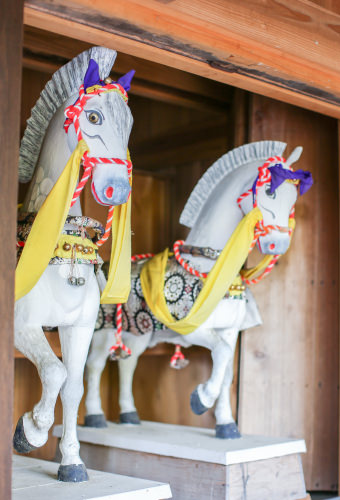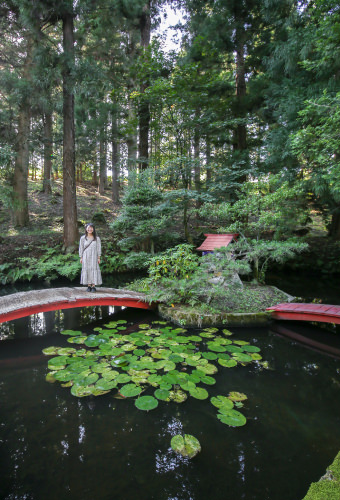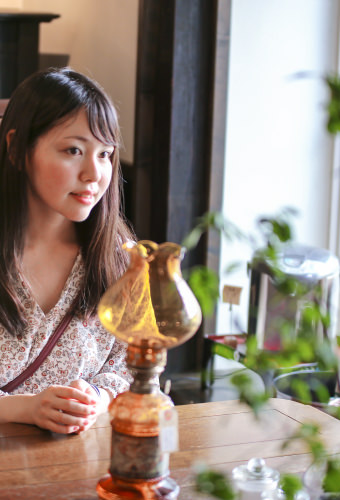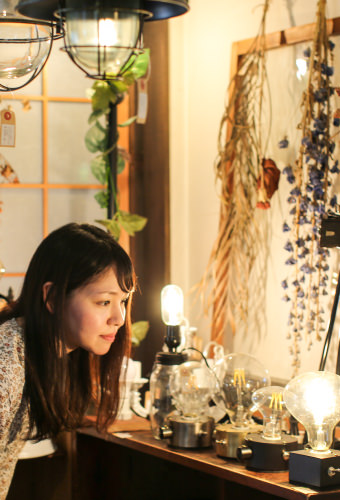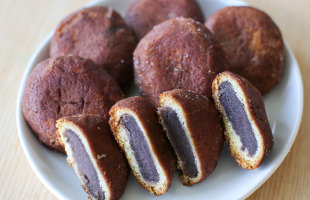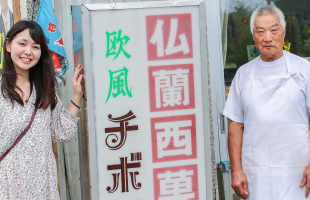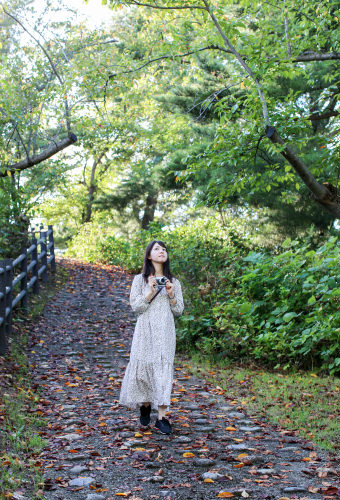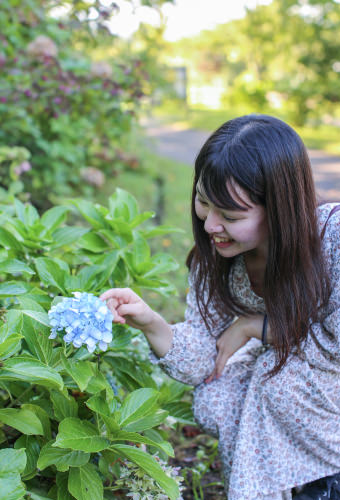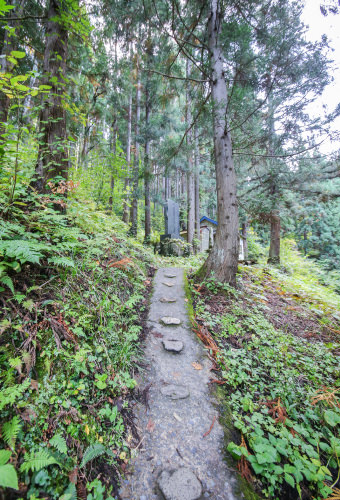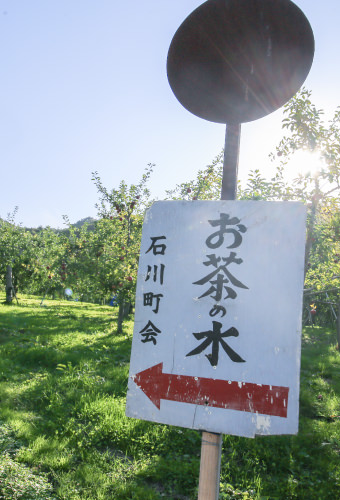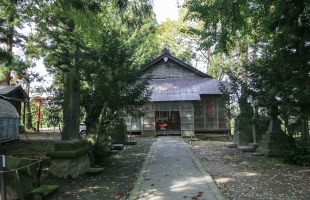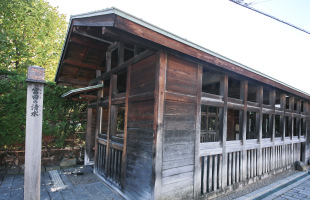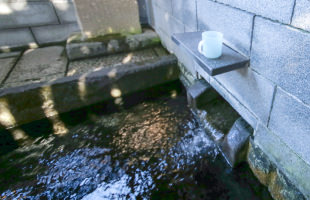Local Festivals’ Yomiya and Countryside Strolls
HIROSAKI
Hirosaki is an historical castle town that is famous for its picturesque cherry blossom viewing and is the highest apple-producing region in Japan. However, there are still many spots that have yet to be introduced in travel guidebooks, including festivals known as yomiya that are held almost every day from spring until fall at over 60 shrines, countryside regions that were once central areas in history, and more.

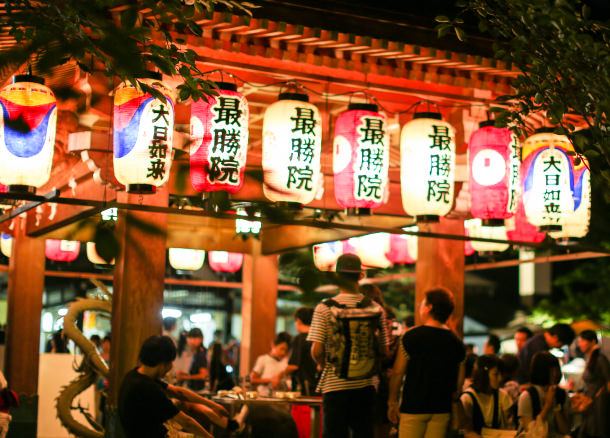
1 Let’s go to the yomiya
Festivals at over 60 shrines from spring to fall!
Over 60 shrines each hold festivals that last one to two days from May to October every year in the Tsugaru region. The pre-event held on the eve of the festival is called the yomiya. All set up, before the sun sets, the stalls are children and adults alike let loose and have fun. The main festival is held the following day, and the stalls are taken down at some places. The main events of that day are the prayers and other activities held by the shrine parishioners from morning till evening.
- For queries about yomiya
- Held from mid-May through early October
(Peak Season is from June to August)
*Festival days differ for each shrine. - Queries: Hirosaki City Tourism Center
Tel. 0172-37-5501
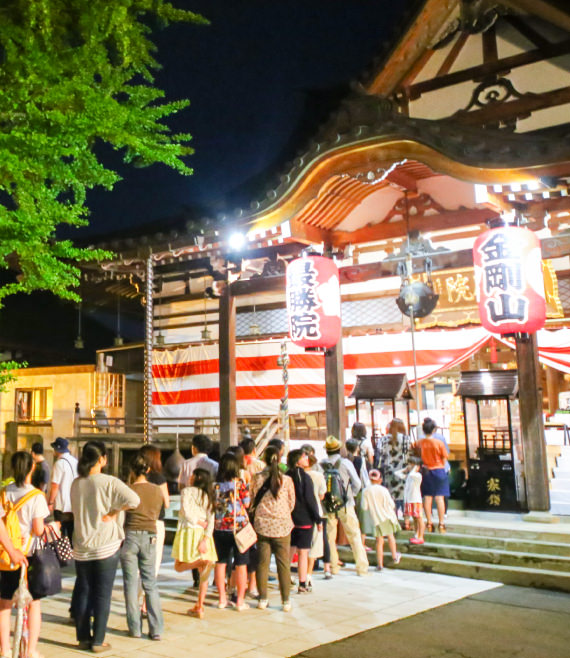
Visit the temple together with family and friends
The most popular yomiya is at Saishoin Temple. This Saishoin is familiar to many as the ‘Ichidai-sama’ for the year of the rabbit, and many people born in the year of the rabbit will visit both for the yomiya and for the new year.
*Ichidai-sama is a tradition specific to the Tsugaru region that has continued since the Edo period. People will visit shrines and temples that enshrine the patron god of their zodiac for exorcisms, the first shrine visit of the year, and other rituals.
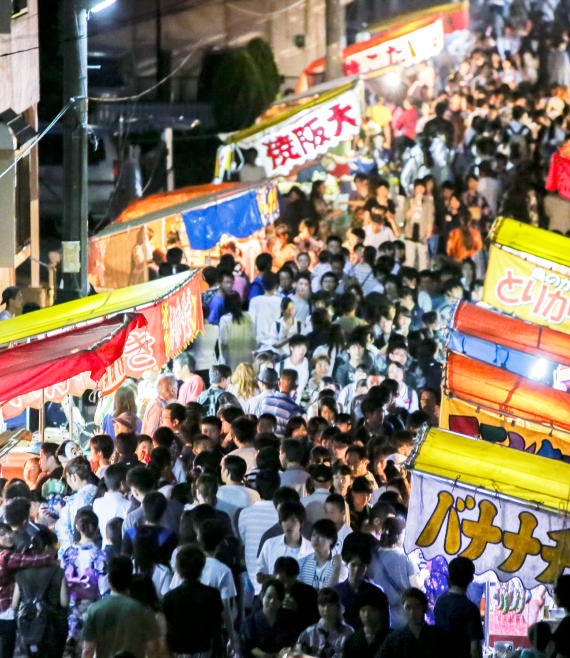
Morning, noon, and evening; sound-only fireworks on the day of the yomiya
On the day of the yomiya, special fireworks that only emit sound are used to announce the festival, beginning in the morning. The “Bang! Bang!” of the fireworks can also be heard at noon as well as in the evening. In areas where yomiya are held, it is an everyday occurrence in the summer festival season to hear people asking, “Which yomiya was that firework for just now?” Saishoin’s yomiya has the greatest number of stalls because it is located in the heart of Hirosaki, making it is easy for people to gather. The line of stalls continues for up to 200m away from the entrance of temple.
- Saishoin Temple
- Queries: Tel.0172-34-1123
- 63 Doyamachi, Hirosaki, Aomori Prefecture
10-minute bus ride from JR Hirosaki Station on the Kinzoku Danchi/Sakuragaoka Line or the Kudoji Line, then a 3-minute walk from Hirosaki Koukou-Mae bus stop
Romantic Yomiya
The 5-story pagoda at Saishoin was built during the Edo period. The pagoda is lit up during the festival, and orange-colored lanterns are also lined up in rows in the temple grounds. This scenery is perfect as a date spot for young people. Wearing a yukata during the yomiya will make the festival even more enjoyable! *There are also some kimono shops and lodging facilities in Hirosaki that offer yukata rentals from June to August for a fee.
- Contact
- Hirosaki Tourism Convention Bureau
- Tel. 0172-35-3131
- https://www.hirosaki-kanko.or.jp/web/edit.html?id=yukatarental
A showcase of matoi, kagura, and the lion dance
You can witness awe-inspiring and solemn Shinto rituals at the festival. Depending on the shrine, you might be able to watch an offering to the gods in the form of a traditional cultural dance, such as a kagura performance or a lion dance. You may also see local firefighter squads showcasing their matoi, traditional standard flags that used to be waved about to relay the location of a fire to other firefighters. Be sure to inquire beforehand to see them. The pictures below introduce the unique characteristics of some of the festivals.
A strange local festival: Onizawa’s Naked Pilgrimage
Onizawa’s Naked Pilgrimage is a traditional event that began during the Edo period and has continued for over 400 years. Early in the morning of the first day of the lunar new year every year, men wearing fundoshi, a Japanese loincloth, purify their bodies while submerged in icy water. They then carry shimenawa, a type of rope used to close off consecrated areas, and walk in a procession around town.
- Access to Onizawa’s Naked Pilgrimage
- Held on the first day of the Lunar New Year *Date changes every year.
Queries: Onizawa Naranoki Tochi Kairyou-ku Tel. 0172-98-2141
Shobuzawa Onizawa, Hirosaki, Aomori Prefecture
40 min by bus from JR Hirosaki Station on the Ajigasawa line or the Dougasawa Line, then a 5-minute walk from Onizawa bus stop
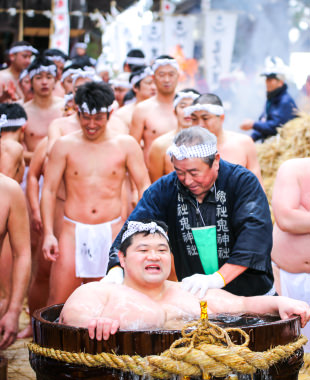

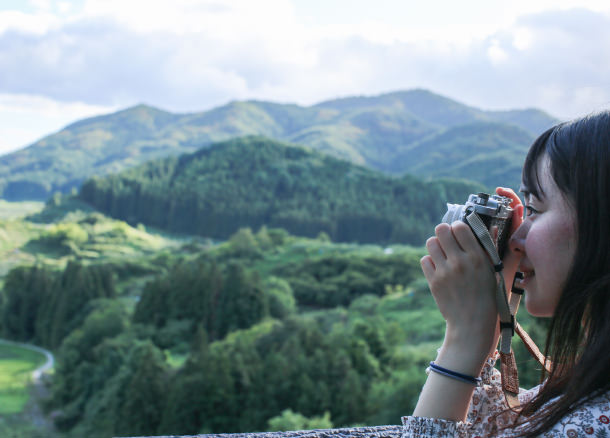
2 A stroll in the countryside
Walk around Koguriyama and Ishikawa
If you get off Tsugaru’s local railway (Konan Railway Owani Line) before the end of the line, countryside scenery stretches out before you. Apple and chestnut orchards sit next to local homes, elegant warehouses and other fun discoveries await. In the Koguriyama and Ishikawa areas, there are warm and soothing shops and scenery, and many other attractions that have yet to be introduced in guidebooks.
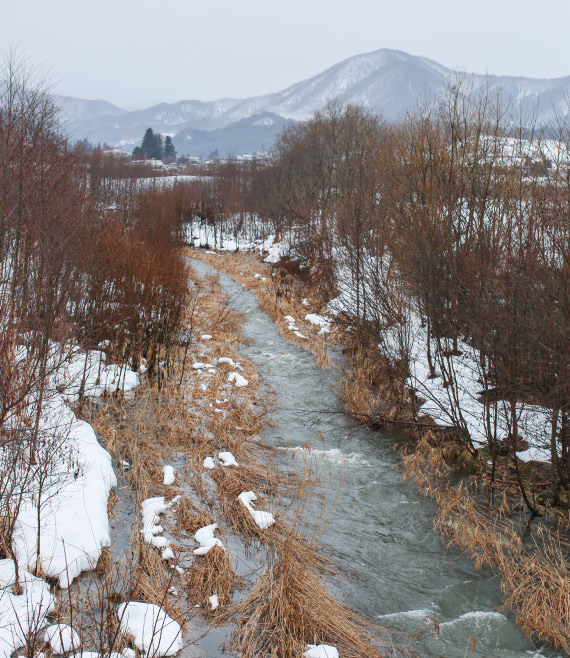
The Koguriyama area
It is said that a chestnut forest used to cover the face of Mt. Koguriyama long ago. When apple production picked up in the region, farmers began to plant apple seeds instead of chestnuts, and the surrounding area was transformed into apple orchards. Despite this, cool and clear marshes, ponds, grassy plains, forests, and other elements of countryside scenery remain even today, and the scent of the wind will make you feel nostalgic.
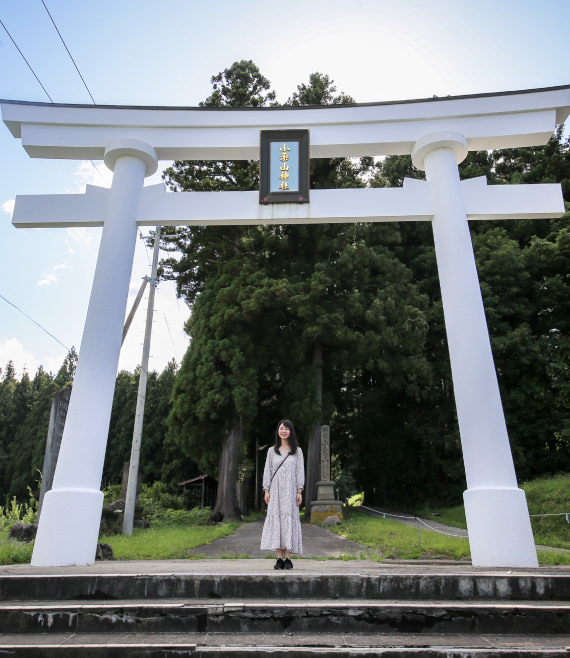
Koguriyama Shrine, where the sacred white torii stands
The white torii gate at Koguriyama Shrine is a landmark that stands to the side of the Apple Road, a farming road that runs between apple orchards. The path to the shrine is shaded and kept cool by the cedar trees that line the road. Just past that is a shrine pond with a mysterious atmosphere. A komainu or lion-dog statue stands before the main shrine, and on the mountain’s slope, there is a small shrine where cute wooden horses are lined up together. You can see that the people of this region are very close to the gods, as even local children can be seen visiting the shrine together with their friends.
- Koguriyama Shrine
- Sawabe, Koguriyama, Hirosaki, Aomori Prefecture
18-minute walk from Koguriyama Station on the Konan Railway Owani Line
Legend of the three sisters of Koguriyama Shrine
According to the legend of the Tsugaru region, there used to be three sister gods who wanted to be the gods of Mt. Iwaki.
There is a story that the eldest daughter became the god of Oguriyama, the third daughter became the god of Iwakiyama, and the second daughter became the god of other mountains. (There are various theories)
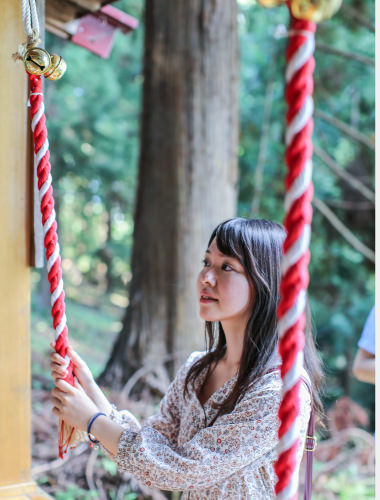
Koguriyama Shrine’s Yomiya
Perhaps due to the legend above, Koguriyama Shrine’s yomiya festival is held on a different day to the yomiya at the third sister’s Iwakiyama Shrine and the second sister’s shrine. (There are various different theories.) The festival stalls are set up near Koguriyama Noson Koryu Park, which is on the road to the shrine, and not near the torii gate. It takes about 10 minutes to walk from the stalls to the shrine, but the local children chat with their friends on the way, pray at the shrine, and then head off to enjoy the festival stalls.
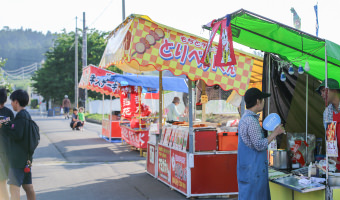
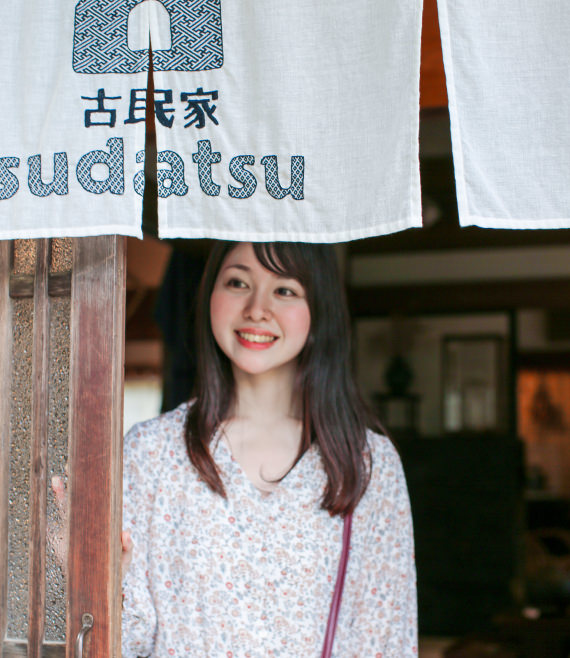
Kominka Sudatsu: A cute and retro variety store in Koguriyama
At first, the owner renovated the traditional Japanese home to be his studio. Then, he started gathering things he liked and “thought were somewhat interesting,” and before long it turned into a shop with a “comfortable atmosphere”. The large shop has tons of retro and tasteful goods for sale, such as stationary, antique furniture and decorations, and lighting fixtures. There is also a wide selection of goods unique to Tsugaru, including kogin-zashi embroidery. The Japanese-style room with a veranda is also rented out for events.
- Kominka Sudatsu
- Opening Hours: Weekdays 10:00-15:00
Weekends & Holidays 10:00-17:00 - Closed: Wednesdays
- Tel. 0172-78-1207
- 137 Komatsugasawa, Koguriyama, Hirosaki, Aomori Prefecture
8-minute walk from Koguriyama Station on the Konan Railway Owani Line
A nostalgic atmosphere filled with exciting things
According to the owner, the traditional house was far colder than he imagined during his first winter, and there were times when the outside temperature felt considerably warmer. However, now that it is filled with retro goods, the traditional house is bathed in a warm atmosphere. The moment you enter the store, there are numerous goods on display that will tickle the fancy of anyone who has a girlish heart and likes cute things.

Chibori Cake Store’s Tanuki Cake with 40 years of history
The owner has been making the Tanuki Cake (230 yen per slice) for 40 years in order to bring smiles to the faces of local children. Since the cake is handmade, the tanuki (Japanese raccoon dog) all have different facial expressions, and the children who come regularly like to joke about how “today’s tanuki have scary faces”. The store is well ingrained in the local community, even taking part in events at local elementary schools. They sell a selection of treats that would please any hungry child on their way home from school, including dorayaki (100 yen per piece), red bean donuts (80 yen per donut), apple cake (60 yen per piece), and toast (30 yen per slice)!
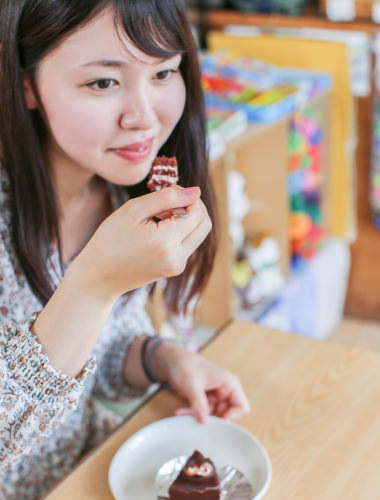
The Japanese sweets are also delicious
The owner studied western confectionary at a long-running store in Yokohama, then developed his skills in Japanese confectionary in Aomori City. We recommend the Japanese sweets filled with red bean paste.
- Chibori Cake Store’s
- Opening Hours: 10:00-18:00 Closed: No regular closing days
- Tel. 0172-87-4533
- 140-1 Kawaai, Koguriyama, Hirosaki, Aomori Prefecture
4-minute walk from Koguriyama Station on the Konan Railway Owani Line
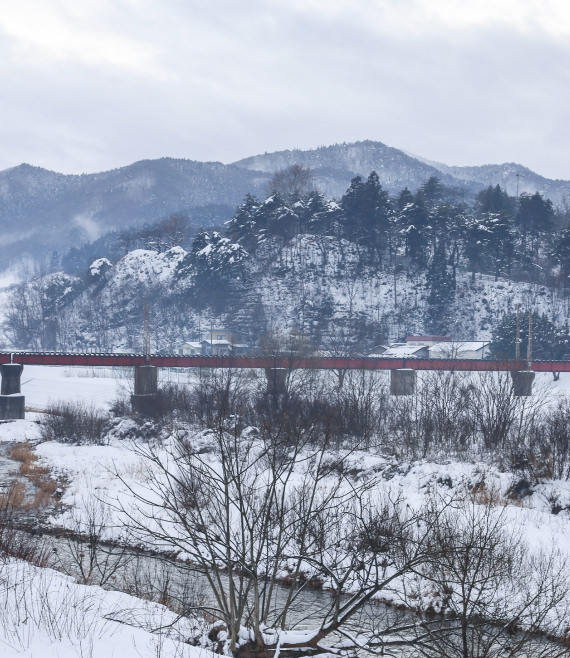
The mysterious Ishikawa district was once filled with castles!?
This small hill next to the Hira River, which flows through the mountains, is currently called Daibutsu Park. Long ago, it used to be called Daibutsugahana, and a castle stood here from the Muromachi period to the early Edo period. Legend says that thirteen different castles (collective name: Ishikawa Castle) were built around the Ishikawa district, with Daibutsugahana at the center. In the end, Lord Ishikawa was defeated by Tsugaru Tamenobu, the first daimyo of the Hirosaki domain, and all the castles were destroyed. Nowadays, you can see some of the remains of the castle districts, earthworks, and the Otemon Gate in Daibutsu Park. However, the land where Ishikawa Castle once stood has now become fruit orchards and residential areas, with most traces of the castle no longer remaining.

This old battleground is now a great spot to capture a panoramic photo of local railroads and the Tsugaru Plain
Daibutsu Park is well-loved by the locals as a great place to rest and enjoy rich greenery and splendid views. As the park looks out over both the Konan Railway Owani Line and the JR Ou Main Line, you often see tourists with their cameras in hand. Furthermore, it is a famous spot for hydrangeas with 2,500 bushes spread throughout the park, and the Daibutsu Park Hydrangea Festival is held here every July. Nowadays, the park is surrounded by tranquil scenery, but long ago this is where Tsugaru Tamenobu took his first step towards uniting Tsugaru. It can also be interesting to imagine the area in the midst of war.
Hidden behind the hydrangeas, caves leading all the way to Hirosaki Castle!?
In Daibutsu Park, there are some caves that are just big enough for a person to pass through. Piled up on top of one another, they seem to have been made for some specific purpose. However, no one knows precisely what that purpose is. There are several legends, including that it is a secret path to Hirosaki Castle or the traces of someone digging up treasure. (There are various different theories.) *You cannot enter the caves.
- Daibutsu Park
- 1 Daibutsu Ishikawa, Hirosaki, Aomori Prefecture
8-minute walk from Ishikawa Station on the Konan Railway Owani Line
*The park is closed during winter due to snow
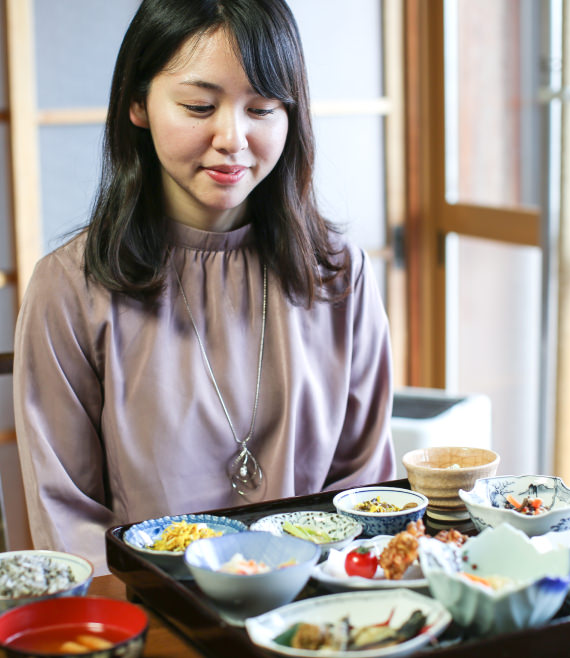
Ishikawa’s Tsugaru Akatsuki no Kai
You can try Tsugaru’s traditional cuisine at a regular house in Hirosaki’s Ishikawa district. The members of Tsugaru Akatsuki no Kai are predominantly housewives. They serve up simple, yet flavorful, dishes unique to the Tsugaru region using wisdom passed down through generations, such as how to dry and ferment wild vegetables and seafood.
Tsugaru’s traditional cuisine, click here.
- Tsugaru Akatsuki no Kai
- Tel. 0172-49-7002
- 44-13 Yagishi Ishikawa, Hirosaki, Aomori Prefecture
5-minute walk from Ishikawa Station on the Konan Railway Owani Line - *Active on Thursdays, Fridays, Saturdays, and Sundays from 12:00-14:00
1 Meal: ~1,500 Must be a group of 4 or larger.
You must make a reservation at least 4 days in advance
Ochanomizu: Mountain Spring Water
When the emperor came to the area on an imperial visit in the 14th year of the Meiji era (1881), he drank tea prepared with water from this spring. To commemorate this, the spring was called Ochanomizu, which means ‘tea water’. Surrounded by a dark green mountainous cedar forest, this spring is often used for drinking water by apple farmers and people who work in the mountains. The spring was also selected as one of the top spring waters of Aomori Prefecture.
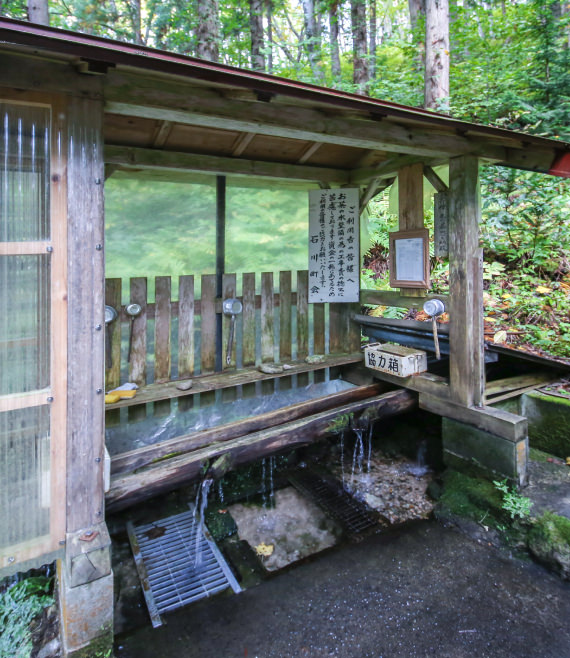
There is even a trekking course where ninjas trained!?
An approximately 12.2 km long mountain path stretches from Ishikawa Station to Tsugaru Osawa Station, passing through Daibutsu Park, Mt. Obiraki, and Mt. Dogataira. This route has been designated as a Tohoku Nature Trail called the Famous Water and Ninja Training Trail.
*The Famous Water and Ninja Training Trail is sometimes unclear due to the state of path maintenance. It is necessary to bring equipment suited to hiking, such as hiking boots and appropriate clothing. Also, beware of bears in the area.
- Ochanomizu
- Hiking Season: May to November
- Queries about Tohoku Nature Trails:
Aomori Prefecture Tourism and International Affairs Strategy Bureau, Tourism Planning Division - Tel. 017-734-9387
- Nishinosawa, Ishikawa, Hirosaki, Aomori Prefecture
1-hour walk from Ishikawa Station on the Konan Railway Owani Line
\ANOTHER SPOT/
Hachimangu Shrine’s Oniko Torii
A short 5-minute walk away from Ishikawa Station, there is a small thicket of trees in the middle of several apple orchards. Inside the thicket, a few red torii gates stand in a row, and there is an oni enshrined on one of them. If you are interested in learning more about Tsugaru’s oniko, click here.
- Hachimangu Shrine
- 62 Terayama, Ishikawa, Hirosaki, Aomori Prefecture
5-minute walk from Ishikawa Station on the Konan Railway Owani Line
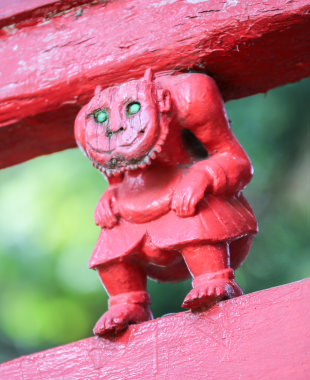
Tomita no Shitsuko: Hirosaki’s Downtown Spring Water
There is a fresh spring inside this small wooden hut. The water is separated into several basins for different purposes, with the basin closest to the spring for washing rice, the next one for washing your face, and the last basin for laundry. The water flowing directly from the spring is reserved for drinking. You often see locals going to the hut to collect spring water. The water was also used to make traditional washi paper from the Edo period to the early Showa period.
- Tomita no Shitsuko
- 5-2 Kamisukimachi, Hirosaki, Aomori Prefecture
8-minute walk from Chuo Hirosaki Station on the Konan Railway Owani Line
